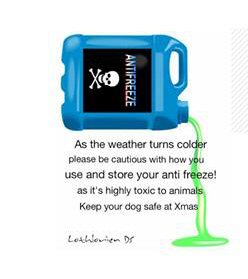
Antifreeze is different from De-Icer which is different from screenwash. There are many DIY recipes for making Screenwash, but the following is the one my elderly uncle uses and recommends (I would suggest doing a bit of research and seeing which version suits you best):
1) 1 Tablespoon of dishwashing liquid
(Fairy by preference which apparently DOES make a difference)
2) 250 ml of Rubbing Alcohol (Amazon Link for Rubbing Alcohol)
3) Make the solution up to 1 gallon in volume by adding water
4) Works out at about £2.60 per gallon and should work to about -30 degrees
De-icer is something that is used on your car windscreen to break down the ice rather than having to scrape the window. His recipe for this would be:
50% water -v- 50% rubbing alcohol in a small spray bottle – works brilliantly (better than the stuff you can by commercially apparently 
Now back to the point of the blog. Antifreeze – Antifreeze, is something that is added to the cooling system of your car so that the radiator does not freeze when temperatures plummet. Antifreeze may be listed on containers as either ethylene glycol or ethan-1,2-diol (the newer more correct name for ethylene glycol). Its the same substance and highly toxic to dogs and cats.
Antifreeze can be dangerous in three ways either by absorption through the skin should the dog walk through it, say from a dripping car radiator, from secondary ingestion should the animal try to lick his coat clean, and by primary ingestion if the dog should come across the actual puddle of antifreeze itself and lap it up (apparently, they just love the taste of it!)
Antifreeze can cause convulsions, collapse, coma and may even be fatal so swift action is required.
IMPORTANT – Administer an emetic ASAP
(an emetic is a substance that will make the dog vomit – for full information on treating poisons and inducing vomiting, please click on the poisoning link: Poisoning Blog
A good thing to try is either an appropriately sized lump of washing soda crystals, hydrogen peroxide 3%, mustard powder made into a paste or rock salt/salt water)
– Ensure the dog discontinues licking ASAP
– Wear gloves when cleansing the contaminant away
– Clean in/around the mouth with water (use a flannel if necessary)
– Ensure the dog does not swallow the cleaning water
– Clean the fur thoroughly with soap/water
– Contact the vet and transport immediately to the vet
– Make a note of the time it occurred
– Monitor A,B,C’s (Airway, Breathing, Circulation) and be ready to step in and perform CPR or artificial respiration as required.

Consideration should also be given to the use of VODKA as a possible aid to treatment (the brand is irrelevant). Ideally this should be administered intravenously (IV) by your vet but a measure of vodka to drink (preferably after the dog has vomited) as a non-prescription treatment to get things underway certainly won’t do any harm.
Please make sure you know how much vodka you have given the dog so you can tell the vet when you arrive as it may alter his dosage and treatment of your pet. Also, please take a bottle of vodka with you if you have it, just in case the vet does not have any on site when you arrive and would like to use this method to help your dog.

